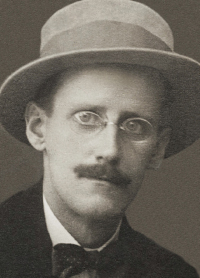On this date in 1882, Irish novelist James Augustine Aloysius Joyce was born in Rathgar, a suburb of Dublin, into a prosperous Catholic family. They moved constantly in search of cheaper lodgings after his father’s drinking and financial irresponsibility landed the large family into poverty. He was educated in convents and by the Christian Brothers, who pressured him to become a Jesuit. But Joyce rejected Catholicism by the age of 16.
He enrolled in the University College of Dublin in 1898. As a student in 1904, he published a broadside, “The Holy Office,” satirizing the Celtic revival. After living for a time in Paris, Joyce moved to Trieste, Italy, with Nora Barnacle of Galway, whom he finally married in 1931 after years together and two children. In 1904 he wrote to Nora: “Six years ago I left the Catholic church, hating it most fervently. I found it impossible for me to remain in it on account of the impulses of my nature.”
Dubliners, his book of short stories, was published in 1914. Although James’ last glimpse of Ireland was in 1912, as an expatriate he meticulously set his novels there. A Portrait of the Artist as a Young Man was published in London in 1916 after an enraged Irish printer had destroyed the first edition of the novel in 1912. James and his family, including children Giorgio and Lucia, lived on the continent thereafter. Lucia was schizophrenic and was institutionalized from the late 1930s until her death in 1982.
Joyce’s Ulysses, documenting one day in the life of Leopold Bloom in Dublin circa 1904, was published in Paris in 1922. It was banned for many years in Great Britain and the U.S. It took Joyce 17 years to finish the stream-of-consciousness Finnegans Wake, published in 1939. Joyce employed the idea of “epiphanies,” or sudden consciousness, in his work.
According to photographer Andres Serrano, when he told Joyce he wanted to capture his soul, Joyce replied: “Forget the soul. Just get the tie right.” (Who’s Who in Hell by Warren Allen Smith.) When arrangements for Joyce’s burial were being made in Switzerland, a Catholic priest offered to officiate but Nora declined, saying she “couldn’t do that to him.” (James Joyce by Richard Ellmann, 1959.)
Joyce underwent surgery in Zürich for a perforated duodenal ulcer in January 1941. He fell into a coma two days later and a month short of his 59th birthday. He is buried in Zürich along with Nora, who survived him by 10 years, and Giorgio, who died in 1976. Lucia is buried in England.
PHOTO: Joyce in 1915 in Zürich.


